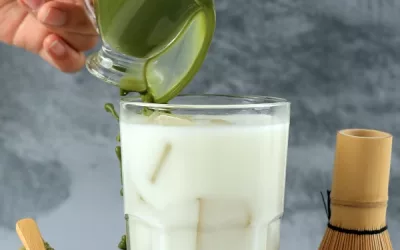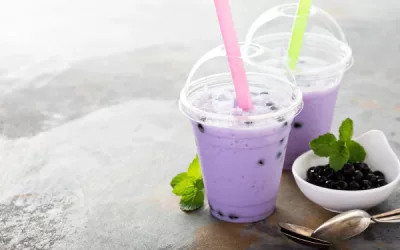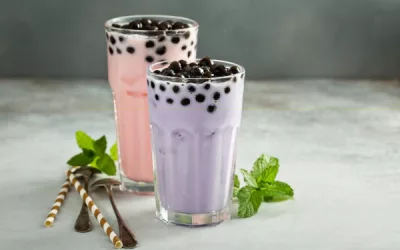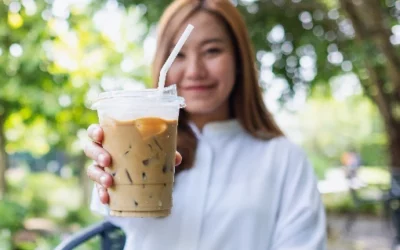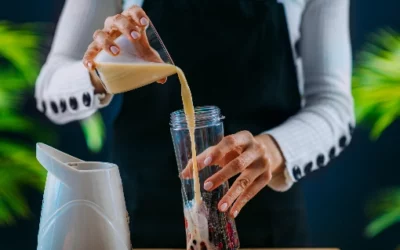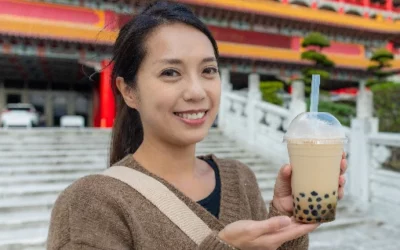I still remember the first time I sipped on a deliciously creamy bubble tea. It was a hot summer afternoon, and as I curled my fingers around the cool cup, the sweet aroma of tea mixed with the chewy tapioca pearls took me on an unexpected journey. Have you ever wondered where this beloved drink comes from? You’re not alone!
In this article, we’re diving into the fascinating history of bubble tea, tracing its origins back to the vibrant streets of Taichung, Taiwan, in the 1980s and discovering how it transformed from a local treat into a global phenomenon. Join me as we explore the origins, variations, and cultural significance of this delightful drink. It’s time to sip into its rich story!
Table of Content
- What is the origin of bubble tea?
- How did bubble tea gain global popularity?
- What are the different variations of bubble tea?
- What is the cultural significance of bubble tea?
- How has bubble tea influenced modern Asian culture?
- Why is bubble tea popular among younger generations?
- What cultural symbols are associated with bubble tea?
- How has the bubble tea industry evolved?
- What are the key ingredients in bubble tea?
- How has bubble tea been adapted in different cultures?
- What is the future of bubble tea?
- Conclusion
What is the origin of bubble tea?
Bubble tea, also known as boba tea, has a captivating history that ties into the vibrant culture of Taiwan. It all started back in the 1980s in the city of Taichung. Liu Han-Chieh, a tea shop owner, kick-started this trend by experimenting with different ingredients in traditional Taiwanese tea. The drink has come a long way since then, transforming from a local novelty into a global phenomenon.
Bubble tea’s early days saw the inclusion of tapioca pearls, which have since become the drink’s defining characteristic. Initially, these pearls were added as a playful twist to the drinks, creating a unique texture and fun experience for consumers.
Over the years, the recipe for bubble tea has evolved, incorporating various flavours, milk, and even chewy toppings.
Who invented bubble tea?
Liu Han-Chieh, a Taiwanese tea shop owner, is credited with inventing bubble tea. His tea shop, Chun Shui Tang, became the epicentre of this new drink, capturing the imagination of tea lovers in Taiwan and beyond. Liu’s experiments with cold tea and non-traditional ingredients created what we now know as bubble tea.
- Liu Han-Chieh was a tea enthusiast with a knack for innovation.
- He owned Chun Shui Tang, a tea shop in Taichung, Taiwan.
- Liu began experimenting with cold tea in the early 1980s.
- His key creation was tea with tapioca pearls, the latter being originally used in desserts.
Chun Shui Tang offered a refreshing take on traditional tea, and the addition of tapioca pearls made it stand out. Liu’s vision and willingness to experiment resulted in a drink that has delighted taste buds worldwide.
Where was bubble tea first created?
Bubble tea was first created in Taichung, a bustling city in Taiwan. With its vibrant food scene and cultural richness, Taichung provided the perfect backdrop for the birth of bubble tea. The city is known for blending traditional and modern culinary practices, making it a hub for innovative food and drink creations.
- Taichung is located in the heart of Taiwan.
- The city is famous for its night markets and diverse food offerings.
- Taichung’s culinary landscape fuses tradition with modernity.
- The city’s tea culture provided a fertile ground for innovation.
Taichung’s dynamic environment encouraged culinary pioneers like Liu Han-Chieh to introduce new flavours and textures, eventually leading to the creation of bubble tea.
What were the initial ingredients used in bubble tea?
The first iterations of bubble tea were relatively simple. They included tea, sugar, and milk, with the tapioca pearls adding a unique texture. Over time, the recipe has adapted to include a variety of ingredients, but the core components have remained consistent.
- Tea: Typically black or green tea served as the base.
- Sugar: Added for sweetness.
- Milk: To create a smooth, rich texture.
- Tapioca pearls: Introduced a chewy element that distinguished bubble tea.
These humble ingredients laid the foundation for a drink that would captivate millions. The blend of flavours and the unique texture set bubble tea apart from other beverages, making it a beloved treat.
In the late 20th century, bubble tea began to spread beyond Taiwan, reaching countries like Japan and the United States. By the early 2000s, it had become an international sensation. The drink’s popularity continued to grow, driven by its Instagram-worthy appearance and the rising interest in Asian cuisine.
Reflecting on the personal connection to bubble tea, I remember the first time I tried bubble tea at a small café in Copenhagen. The experience was unlike any other drink—chewy tapioca pearls paired with sweet, milky tea, the burst of flavours was enchanting.
It was easy to see why bubble tea had gained such a massive following. Each sip was a delightful discovery, making the drink feel oddly nostalgic and refreshingly new.
Liu Han-Chieh’s innovation at Chun Shui Tang and the curious culinary culture of Taichung have left a lasting imprint, inspiring food trends worldwide. Bubble tea stands as a testament to the power of cultural fusion and creativity in the culinary arts.
How did bubble tea gain global popularity?
Bubble tea, also known as boba tea, began its journey in Taiwan in the early 1980s. Since then, it has become a global phenomenon, captivating taste buds and sparking cultural curiosity across continents. This fascinating drink’s journey from local favourite to international superstar involves a combination of cultural exchange, social media influence, and culinary innovation.
The initial spread of bubble tea outside Taiwan can be attributed to the Taiwanese diaspora. Immigrants and students introduced this unique beverage to various parts of the world, creating a foundation for its popularity in new regions. As people from different backgrounds encountered bubble tea, its novelty and delightful texture quickly won fans.
The role of social media cannot be understated in the rise of bubble tea’s popularity. Platforms like Instagram and TikTok have amplified the drink’s appeal by showcasing its vibrant colours and customisable options. Influencers and celebrities have further propelled its fame, making bubble tea a trendy and must-try beverage.
To understand how bubble tea gained global popularity, we can look at key regions and the factors contributing to its spread:
| Country/Region | Year of Introduction | Factors Contributing to Popularity |
|---|---|---|
| Taiwan | Early 1980s | Origin, unique flavours, local popularity |
| Japan | Early 1990s | Close cultural ties, novelty appeal |
| United States | Mid-1990s | Taiwanese diaspora, novelty, social media |
| Canada | Late 1990s | Cultural diversity, student population |
| Europe | Early 2000s | Trendy appeal, social media influence |
| Australia | Early 2000s | Cultural diversity, health trends |
| China | Late 2000s | Cultural affinity, customization options |
This table provides a snapshot of the spread of bubble tea across different regions, highlighting the timeline and key factors that contributed to its popularity.
Social media has played a crucial role in the global rise of bubble tea. Platforms like Instagram, TikTok, and YouTube have transformed this drink into a visual and cultural icon.
The vibrant colours, unique textures, and customisable nature of bubble tea make it highly photogenic and shareable.
- Visual appeal: The colourful and unique presentation of bubble tea is perfect for social media.
- Influencer endorsements: Celebrities and influencers have popularised bubble tea through posts and videos.
- Trendiness: Sharing bubble tea experiences has become a trend, attracting new fans.
- Global reach: Social media breaks down geographical barriers, spreading trends quickly.
Social media has not only amplified bubble tea’s appeal but also fostered a global community of enthusiasts, ensuring its place in contemporary food culture.
Bubble tea’s journey from Taiwan to the world is a testament to the power of cultural exchange and modern technology. This drink’s popularity continues to grow, with new flavours and innovations keeping the global audience engaged.
In the 1990s, Taiwanese immigrants in the United States began opening bubble tea shops, particularly in California. The drink quickly gained a following among young people and adventurous eaters. By the early 2000s, bubble tea had spread to Canada and various parts of Europe, where it was embraced for its novelty and deliciousness.
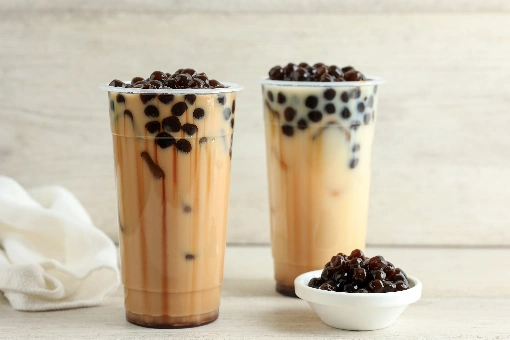
What are the different variations of bubble tea?
Alright, let’s dive right into the colourful world of bubble tea. This popular drink, born in Taiwan during the 1980s, has exploded into an international sensation. Over time, it has morphed into a myriad of variations that can boggle the minds of even the most seasoned tea lovers.
To make it simple, bubble tea can be categorised into several main types: milk tea, fruit tea, yogurt tea, popping boba, and jelly toppings.
One of the earliest and most beloved versions is milk tea. Imagine a creamy blend of tea, milk, and that magic ingredient: chewy tapioca pearls. Next, we have fruit tea, which is a refreshing concoction that combines fruit infusions with those delightful bubbles.
Yogurt tea is another interesting twist, where tangy yogurt meets the fun and chewiness of bubbles. Then there’s popping boba – those bursting balls filled with flavours that explode in your mouth. Last but certainly not least, jelly toppings add a different texture and taste profile to the mix.
When it comes to the various flavours and toppings, the possibilities are practically endless. People across the world have embraced and adapted this drink, resulting in unique regional versions packed with local flavour.
What are the most popular flavours of bubble tea?
You’d be hard-pressed to find someone who doesn’t have a favourite bubble tea flavour. Here are the ones that have won hearts globally:
- Classic Milk Tea: You can’t mess with the original, can you? This combines black tea, milk, and sugar with those iconic tapioca pearls.
- Taro Milk Tea: This vibrant purple drink is made with taro root, giving it a sweet, nutty flavour.
- Matcha Milk Tea: For the green tea aficionados, matcha milk tea offers a rich, earthy taste.
- Honeydew Milk Tea: Cantaloupe-like honeydew flavour that’s both sweet and refreshing.
- Wintermelon Tea: A sweet and slightly caramel-ish flavoured tea, perfect for those looking for something different.
These popular flavours have stood the test of time, providing comfort and delight with every sip. From the velvety richness of taro to the refreshing sweetness of honeydew, there’s a flavour for every palate.
How do toppings vary in bubble tea?
Once you’ve picked your flavour, it’s time to choose your toppings. These aren’t just decorations; they can completely transform your drink. Here’s what you can expect:
- Tapioca Pearls: The OG topping. Chewy, slightly sweet, and a must-have for many.
- Popping Boba: These are like flavour bombs in your mouth, filled with fruity juices that burst as you bite.
- Aloe Vera: Slightly crunchy and refreshing, perfect for a lighter option.
- Grass Jelly: Earthy and herbal, these gelatinous cubes add a unique texture.
- Pudding: Usually egg-based, this is for those who like their tea with a custardy twist.
Bringing a harmony of textures and flavours, these toppings enable you to customise and elevate your bubble tea experience to new heights.
What are the unique variations of bubble tea in different regions?
What’s fascinating is how bubble tea has adapted to the tastes and cultures of different regions around the world. Here’s a quick world tour:
- Japan: They’ve taken bubble tea up a notch with flavours like matcha and hojicha, offering a deep, roasted alternative.
- United States: The focus is often on creativity, with options like Oreo milk tea or avocado bubble tea.
- Thailand: Thai milk tea, with its vibrant orange hue and robust flavour, has made its way into the bubble tea scene.
- Philippines: Halo-halo-inspired bubble tea, anyone? Mixing beans, coconut strips, and jellies with tea.
- Australia: Australians enjoy a fresher take, with lots of fruit-based teas and local ingredients like finger lime.
These regional variations not only reflect local preferences but also highlight the versatility and universality of bubble tea.
Back in the 1980s, when Liu Han-Chieh & Lin Hsiu Hui first created bubble tea in Taichung, Taiwan, they probably never imagined it would take over the world. Interestingly, the first conception involved adding sweetened tapioca pudding to cold tea, a little experiment that has grown into a global phenomenon.
Each region adds its own twist, proving that while bubble tea may have Taiwanese roots, its branches extend worldwide. Now, whether you’re into the classics or something avant-garde, there’s a bubble tea out there just waiting for you to slurp it up. Cheers!
What is the cultural significance of bubble tea?
Bubble tea—affectionately known as boba—has exploded like confetti at a New Year’s party across the globe. This quirky concoction of tea, milk, fruit flavours, and tapioca pearls doesn’t just offer a delightful beverage experience, it has wriggled its way into the cultural fabric of many societies.
From being a staple in social gatherings to representing a slice of modern Asian culture, bubble tea’s impact is nothing short of fascinating. And let’s be real, who wouldn’t want to show off that Instagram-perfect cup of boba? Younger generations have especially embraced it, making it a trendy social experience.
Plus, its global influence is undeniable, and it’s become quite the cultural symbol.
How has bubble tea influenced modern Asian culture?
Bubble tea has not only infiltrated our taste buds but also Modern Asian culture. It’s become a social adhesive in cities where stopping for a boba break is akin to grabbing a coffee with friends elsewhere.
This beverage, first concocted in 1980s Taiwan, is now an unmissable pit-stop in vibrant Asian city life.
- Social gathering spots: Bubble tea shops are hotspots for meet-ups, making them a nexus for community interaction.
- Fashion and branding: The boba shop aesthetic, with its pastel colours and cute mascots, defines the trendy, youthful vibe of many urban centres.
- Cultural pride: Bubble tea symbolises a slice of Taiwan that is now a cultural export, celebrated across different Asian communities.
- Economic impact: The rise of bubble tea chains has boosted local economies and created business opportunities.
- Integration into pop culture: Films, TV shows, and songs from Asia often feature bubble tea, embedding it in the regional narrative.
To wrap this tasty tidbit up, bubble tea has become so ingrained in modern Asian culture that it’s hard to tell if we’re more addicted to the pearls or the social interactions it fosters.
Why is bubble tea popular among younger generations?
Now, if there’s a generation that loves its trends, it’s the younger crowd! Bubble tea checks all the boxes for millennials and Gen Z: It’s cool, it’s customisable, and it’s shareable—both in real life and online.
- Instagram-worthiness: The visually appealing layers, colours, and toppings make for excellent social media content.
- Customisation galore: From the level of sweetness to the choice of add-ons, bubble tea fits right into the “have it your way” mentality.
- Group activity: Sharing and comparing boba drinks have become a go-to social activity.
- Convenience: Quick and accessible, it’s a good on-the-go option for busy, bustling lives.
- Health kick options: With more variations, including fruit teas and less sugary versions, it appeals to the health-conscious youth.
So, whether it’s looking good on the ‘Gram or offering something for every palate, Bubble Tea has bagged the younger generations’ taste buds like no other.
What cultural symbols are associated with bubble tea?
When you think bubble tea, what symbols come to mind? Beyond just the chewy pearls and milky goodness, boba tea holds several cultural symbols that speak volumes.
- Taiwanese heritage: Originating from Taiwan, it’s a point of national pride and cultural identity.
- Unity in diversity: Symbolises a mix of flavours and textures, much like a melting pot of cultures.
- Innovation and modernity: Seen as a trendsetter in the beverage market.
- Youthful exuberance: Its fun, vibrant nature appeals to a youthful spirit.
- Inclusivity: Loved by diverse communities across the globe, it’s a drink that transcends borders.
Bubble tea is much more than just a trendy drink; it’s a modern emblem of cultural fusion, national pride, and youthful excitement.
In Taiwan during the late 1980s, a peaceful protest movement, known as the “Wild Lily student movement,” took place, resembling the flowers’ resilience against the winds of change. Coincidentally, bubble tea—birthed during this tumultuous time—mirrored this spirit.
Initially a simple blend of tea, milk, and chewy tapioca pearls invented by Lin Hsiu Hui at a small tea stall, bubble tea quickly spread beyond borders. Just like the student’s vision for a democratic future, boba tea represented an innovative blend that embraced modernity while respecting tradition.
This historical confluence made an everyday drink an everlasting cultural phenomenon.
How has the bubble tea industry evolved?
If someone told you that sipping on a drink with chewy tapioca balls would turn into a global craze, you’d probably laugh in their face. But here we are. Bubble tea, or boba tea if you’re feeling fancy, has taken the world by storm.
From humble beginnings in Taiwan during the 1980s, it has now sprouted into a lucrative industry with business opportunities galore. Let’s dive into the frothy depths and uncover how this giant tapioca ball we call the bubble tea industry has evolved.
Alright, so businesses saw this weird, quirky drink and thought, “Let’s make it a thing everywhere.” Smart, right? The explosion of bubble tea franchises is insane. We’ve seen bubble tea joints in practically every urban nook and cranny.
What business opportunities has the bubble tea industry created?
Imagine you’re standing in front of a bubble tea shop; it’s bustling with people. You think, “There’s some serious money to be made here.” Well, you wouldn’t be wrong. Let’s break down the profitable ventures this delicious drink has stirred up.
- Retail Outlets: Everywhere from local cafes to huge franchises. So, you can basically start small and dream big.
- Supply Chain: With demand for unique ingredients skyrocketing, suppliers have a goldmine opportunity.
- Merchandising: Bubble tea-themed merchandise, like reusable straws and quirky cups, are cash cows.
- Events & Catering: Boba at weddings or corporate events is now a sought-after novelty.
- Online Marketplaces: Selling DIY bubble tea kits and specialty items online provides another revenue stream.
From the street-side stalls to opulent cafes, the business landscape is rich with possibilities. The most interesting part? Entrepreneurs are still exploring untapped markets and ways to innovate.
How have franchises contributed to the growth of bubble tea?
Franchises, the fast food of the bubble tea world. They are the powerhouses driving boba into mainstream culture.
- Global Expansion: From Asia to America and Europe, franchises are turning bubble tea into a worldwide phenomenon.
- Brand Recognition: Like the golden arches of McDonald’s, bubble tea franchises create consistent experiences that build loyal followings.
- Economies of Scale: Bulk buying of ingredients cuts costs and ensures every cup tastes just right.
- Operational Efficiency: Streamlined operations make it easier for new franchisees to get cracking and start serving.
- Marketing Muscle: Large franchises have the budgets to run splashy ad campaigns, further fuelling bubble tea’s popularity.
Names like Chatime, Gong Cha, and Tiger Sugar are not just brands; they’re boba empires. They bring consistency, quality, and business muscle, all of which contribute to the phenomenon we lap up today.
What are some recent innovations in the bubble tea industry?
Innovation in bubble tea might sound like reinventing the wheel, but brace yourself. The creativity is off the charts. It’s like Willy Wonka’s factory for beverages.
- Healthier Options: Low-sugar, organic, and vegan alternatives are trending.
- Exotic Flavours: Think taro, matcha, and even cheese foam (yes, you read that right).
- Eco-Friendly Packaging: Sustainable materials and reusable straws to please our planet-friendly patrons.
- Artisanal Boba: More focus on hand-crafted tapioca pearls, elevating the texture and flavour.
- Tech Integration: Apps for ordering and customising your drink, making it all the more personal.
These innovations keep the industry fresh and exciting, ensuring that bubble tea lovers always come back for more. From a simple tea base to multifaceted flavour explosions, this beverage isn’t just a trend; it’s evolving.
In the 19th century, when tea merchants like Robert Fortune disguised themselves to smuggle tea plants out of China for the British East India Company, little did anyone imagine that this prized beverage would someday morph into the global bubble tea phenomenon we see today.
From secret missions to boba cravings, tea’s journey has certainly had its twists and turns!
What are the key ingredients in bubble tea?
Let’s talk about bubble tea’s history because, seriously, where all this fuss began matters! I mean, you can’t just dive into boba heaven without appreciating the delightful concoction’s origins. Originating from Taiwan in the 1980s, bubble tea quickly took over the globe like a stealthy ninja of deliciousness, packing some fabulous ingredients that are now the stars of this global sensation.
First off, you need a solid tea base – where else would all that lushness come from? It’s like the rocking foundation of your favourite ballad, keeping the rhythm smooth. Then, there’s milk or milk alternatives, adding that creamy richness which dances flawlessly on your taste buds.
Don’t forget the sweeteners – like a witty comedian’s perfect punchlines, they elevate everything! And then, the pièce de résistance: those chewy, addictive tapioca pearls. Top all this off with other fancy bits like fruit jellies or popping boba, and there you have it, a party in a cup.
What types of tea are commonly used as the base for bubble tea?
You’ve got quite the variety when it comes to the tea base in bubble tea. Think of it as the cast of Game of Thrones – each variety bringing its own spectacular flair and leaving you craving for more episodes of flavour.
Here are some of the showstoppers:
- Black Tea: Robust and bold, this is your Tyrion Lannister of tea bases. Dependable, strong, with a bit of mischief.
- Green Tea: The Sansa Stark of the bunch. Gentle, elegant, and full of hidden depths.
- Oolong Tea: Somewhere between green and black, much like our beloved Arya Stark, offering complexity and a touch of surprise.
- White Tea: Subtle and delicate, almost regal, think of Margaery Tyrell – sophisticated with layers of charm.
- Fruit Teas: Imagine Daenerys on a sunny day, fruity and refreshing, adding a burst of brightness to the brew.
As you can see, there’s a tea base for every mood, ensuring your bubble tea extravaganza is always on point.
What are the different milk alternatives used in bubble tea?
Not a fan of cow’s milk, or just looking to switch things up? Fear not, bubble tea’s got you covered with a range of milk alternatives. Whether you’re lactose intolerant, vegan, or just adventurous, there’s a substitute to suit your every need.
Check out these fantastic options:
- Almond Milk: Light, nutty, and subtly sweet – a crowd pleaser for sure.
- Soy Milk: Creamy and rich, soy milk adds balance and depth to the mix.
- Oat Milk: Almost velvety and slightly sweet, it’s like a luxurious cashmere addition to your tea.
- Coconut Milk: Bringing a tropical flair – refreshing and a tad exotic.
- Rice Milk: Delicate and lightly sweetened, it doesn’t overpower the tea’s flavour.
These milk alternatives perform an excellent balancing act, blending seamlessly into the tea and enhancing the overall taste experience.
How are tapioca pearls made?
Now, let’s dive into those chewy marvels that make bubble tea, well, bubbly! Tapioca pearls are the charming little entities that add texture and fun, making every sip a delightful adventure.
Here’s the lowdown on how these pearls come into existence:
- Start with Tapioca Starch: Derived from the cassava root, this fine powder is the fundamental ingredient.
- Mix with Boiling Water: The starch is combined with hot water to create a doughy mixture.
- Shape into Pearls: The dough is carefully rolled into tiny balls. Think of them as the minions of the bubble tea world – small but full of personality.
- Cook in Water: These tiny pearls are then boiled until they morph into their distinctive chewy form.
- Soak in Syrup: To add a bit of extra sweetness and flavour, they get a nice little bath in a sugary syrup.
Once you’ve got these pearls ready, they’re ready to mingle with the tea, milk, and any other goodies you fancy.
It’s fascinating how a simple root can transform into such a vital component of a beloved tea drink, similar to how the tiny island of Taiwan has influenced global culinary trends.
Let’s not forget the delightful tale of Liu Han-Chieh, the tea shop owner responsible for making bubble tea a star. In Tainan, during the sweltering summer of 1983, Liu Han-Chieh decided to mix traditional Taiwanese tea with some fresh fruits and syrup.
His innovative creation became an instant hit. But it wasn’t until his co-worker, Lin Hsiu Hui, playfully added her tapioca dessert to the tea that bubble tea truly got its signature chewiness.
Such fanciful spontaneity gave rise to the delightful beverage we relish today. A humble tea shop experiment changed the landscape of beverages forever, proving innovation often comes from simple curiosity and willingness to experiment.
How has bubble tea been adapted in different cultures?
Bubble tea, that bubbly concoction of sweet flavours and chewy tapioca pearls, is like the chameleon of the beverage world. Pop it into any country, and it absorbs local tastes faster than a sponge in a puddle.
From Asia to Europe and all the way to the Americas, this drink has been tweaked, twisted, and transformed in more ways than you can count. It’s gone from just tea and milk with a dash of chewy pearls to a kaleidoscope of creativity.
Think of the first time you tried bubble tea—odds are, it probably wasn’t the “original” Taiwanese version. Instead, you might have sipped a version concocted with local flair and a sprinkle of cultural zest.
This adaptability is precisely what’s kept bubble tea so popular and allowed it to thrive globally. Gather ’round, as we dive into some of these delightful adaptations across cultures.
What are some unique regional flavours of bubble tea?
Now, let’s talk flavour. This aspect of bubble tea is as diverse as the cultures tweaking it.
- Matcha in Japan: It’s no surprise that in Japan, you’ll find bubble tea infused with matcha. This green tea powder gives the drink a distinctive blend of bitterness and sweetness, turning it into a taste sensation.
- Red bean in Korea: Korea has added red bean paste to its bubble tea. It’s like a cultural mashup of their traditional red bean desserts and the chewy goodness of boba.
- Durian in Southeast Asia: In places like Malaysia and Singapore, the King of Fruits—durian—has made an appearance in bubble tea. It’s pungent, strong, and undeniably popular.
- Mango lassi in India: India’s vibrant culinary scene has embraced bubble tea by incorporating mango lassi flavours. Think yoghurt, mango, and those good ol’ pearls.
- Chai tea in the UK: In the land of tea-lovers, bubble tea has been infused with chai spices. Because what’s better than mixing two beloved beverages, right?
Each of these regional flavours brings something new to the bubble tea game, adding that extra kick which keeps people coming back for more.
How do local ingredients influence bubble tea variations?
Ah, the importance of local ingredients. Ever notice how regional staples somehow end up in bubble tea? Here’s the scoop:
- Jasmine and hibiscus flowers: In Asia and the Middle East, these fragrant flowers are often steeped into the tea base. Jasmine adds a floral punch, while hibiscus offers a tart, cranberry-like taste.
- Fresh tropical fruits: Tropical havens like Taiwan and the Philippines throw in fresh mango, papaya, or lychee to create a juicy burst of flavours.
- Dairy variations: In Western countries, cow’s milk is sometimes swapped out for almond, soy, or oat milk. Hello, vegan-friendly boba!
- Sweeteners: While cane sugar is the OG sweetener, honey, agave, and even brown sugar syrup are popular alternatives based on regional sweetness levels.
These ingredients not only buff up the bubble tea but also create versions that cater to local palates. So, whether you like your drink milky, fruity, or floral, there’s a bubble tea out there for you, tailored by geographical quirks.
What are some fusion beverages that incorporate bubble tea?
Bubble tea is getting a tad over-confident and making appearances in other beverages. And we’re here for it.
- Bubble tea coffee: For the indecisive caffeine lover, this hybrid combines iced coffee with boba pearls.
- Bubble tea cocktails: Your favourite barista and bartender teamed up, resulting in alcoholic bubble teas. Vodka boba martini, anyone?
- Smoothies with boba: Picture your morning berry smoothie, but with popping pearls thrown in. Now, your nutrients and fun are combined.
- Bubble tea ice cream: Found at niche cafes, it’s essentially bubble tea but frozen. Flavours like taro, matcha, and Thai tea just work better when they’re ice-cold.
- Milkshakes with pearls: Take a classic milkshake, plop in some tapioca, and you’ve got a textural treat on your hands.
These fusion drinks break down the traditional barriers of what bubble tea can be and offer new ways to enjoy your favourite flavours.
When bubble tea first took flight from Taiwan in the 1980s, its journey was akin to a culinary Silk Road. Entrepreneurs like Lin Hsiu Hui started experimenting with philosophies far removed from merely quenching thirst.
She combined traditional Taiwanese tea with chewy tapioca pearls, creating a drink that revolutionised beverage culture. Today, its international success echoes stories of ancient traders who spread silk and spices across continents, adapting and evolving, yet always retaining a core of tradition.
Today’s bubble tea tower of innovation everywhere owes much to those pioneering spirits as it blends tradition with a cosmopolitan twist.
What is the future of bubble tea?
Bubble tea, that quirky drink with roots in Taiwan, has taken the world by storm. You’ve probably seen a shop on every corner, and your Instagram feed is drowning in colourful concoctions. So, what’s next for this beloved beverage? Let’s peek into the crystal ball and explore its future.
As our society becomes more eco-conscious and health-savvy, the bubble tea industry is riding the waves of sustainability, health trends, technological advancements, market expansion, and changing consumer preferences. Welcome to the future of your favourite chewy drink.
How is the bubble tea industry addressing sustainability?
First things first, even bubble tea can’t escape the sustainability bandwagon. Plastic straws, we’re looking at you! The bubble tea industry is stepping up its green game, ensuring you can sip your boba with a guilt-free conscience.
- Biodegradable Straws: Say goodbye to plastic straws and hello to eco-friendly alternatives like rice, algae, or trusty bamboo.
- Sustainable Packaging: more shops are opting for compostable cups and lids, reducing plastic waste one drink at a time.
- Local Sourcing: as the farm-to-table movement grows, bubble tea shops are sourcing ingredients locally, reducing their carbon footprint.
- Recycling Initiatives: more initiatives are being introduced to encourage customers to recycle or bring their own containers.
- Green Certifications: many shops now strive for green certifications, aligning their practices with environmental standards.
Sustainability in bubble tea isn’t just about making your drink Instagram-worthy; it’s about making sure we can enjoy our drinks without wrecking the planet. It’s a win-win situation – delicious boba and a happy Earth!
What are the emerging health trends in bubble tea?
Gone are the days when bubble tea was just sugar-laden and calorie-heavy. The demand for healthier options has bubbled up, transforming your favourite drink into a guilt-free pleasure.
- Low-Sugar Options: with rising health concerns, many bubble tea shops now offer sugar alternatives or lower sugar content.
- Natural Ingredients: brands are incorporating natural and unprocessed ingredients, avoiding artificial flavours and preservatives.
- Functional Additives: from chia seeds to probiotics, bubble tea is now decked out with superfoods that give it a health boost.
- Milk Substitutes: for the lactose-intolerant and vegans, plant-based milks like almond, oat, and soy have become standard offerings.
- Herbal Infusions: integrating herbal teas such as matcha, turmeric, and hibiscus to add more health benefits beyond just a caffeine kick.
Health trends are reshaping the bubble tea landscape, making sure you can indulge without the guilt trip. So, you can sip away knowing your bubble tea is as wholesome as it is tasty.
How is technology influencing the bubble tea industry?
Tech is revolutionising everything, and bubble tea is no exception. From how it’s made to how you order, technology is stirring up a storm in the boba world.
- Smart Ordering: mobile apps and QR codes are making it easier to customise and order your drink without the hassle.
- Automation: robotic arms and machines are taking over tea brewing and boba cooking, ensuring consistency and speed.
- Data Analytics: using customer data for personalised recommendations and inventory management. Your preferences are no longer a mystery!
- Virtual Reality (VR) Promotions: some shops are experimenting with VR to offer immersive drink experiences that are out of this world.
- Online Deliveries: the tech-savvy generation can now get their boba fix with just a few taps on their smartphones, thanks to partnerships with delivery apps.
Technology is brewing a futuristic bubble tea experience that’s faster, smarter, and just plain cooler. Imagine a robot making your favourite matcha milk tea – the future is here, and it’s incredibly exciting.
The bubble tea revolution traces back to Taiwan in the 1980s. But did you know that even historical figures were ahead of their time with quirky drink trends? Take the example of Catherine de Medici of 16th century France.
She was a trendsetter who not only introduced the fork to the French dining table but also popularised the consumption of unusual beverages like hot chocolate. Her embrace of these novelties influenced French cuisine for centuries to come.
In a similar vein, bubble tea isn’t just a drink; it’s a cultural phenomenon that’s poised to influence global food trends for years to come. So, whether you’re a seasoned boba enthusiast or a newbie, the future of bubble tea looks bubbly, delicious, and oh-so forward-thinking. Cheers to that!
Conclusion
As I reflect on the captivating journey of bubble tea from its humble origins in Taichung, Taiwan, to its status as a global phenomenon, I find myself drawn to the myriad factors that have contributed to its rise. Beginning with Liu Han-Chieh’s pioneering experiments with tapioca pearls in the 1980s, the fusion of flavours, textures, and cultural nuances has made bubble tea not merely a drink, but a vibrant symbol of social connection among younger generations.
The significance of bubble tea extends beyond its unique taste and aesthetic appeal; it embodies a cultural bridge that unites diverse communities. The industry’s growth, driven by innovative franchise models and an insatiable demand for creativity in flavours, signals not only economic opportunities but also a reflection of our evolving tastes and preferences. In a world increasingly focused on sustainability and health, the bubble tea industry is adapting, ensuring that this beloved beverage remains relevant and responsible for future generations.
As we look ahead, it’s clear that the potential for bubble tea continues to expand. The exploration of new regional flavours and innovative preparations promises an exciting future filled with surprises. I can’t help but wonder: What will be the next evolution of this beloved drink? Engaging in spaces that promote cultural exchange and collaboration will be essential in shaping the future of bubble tea. After all, the next time you sip this delightful concoction, remember that you are not just enjoying a flavour; you are participating in a global narrative, a delicious chapter in food history that keeps unfolding.
Resources
- Effects of chronic bubble tea administration on behavior and cognitive function in mice
- Evolution of Bubble Tea Industry
- Consumer Preference Analysis on Attributes of Milk Tea
- Understanding Consumers’ Intention to Revisit Bubble Tea Stores
- The Bubble Tea Industry: How One Drink Found Global Success
- Calories and sugars in boba milk tea: Implications for obesity risk in Asian Pacific Islanders


